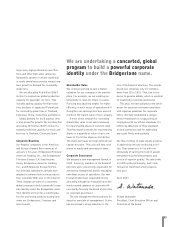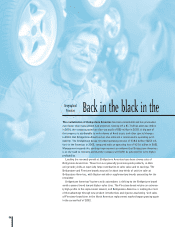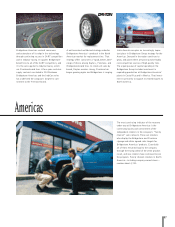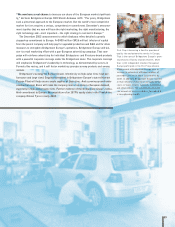Bridgestone 2002 Annual Report Download - page 17
Download and view the complete annual report
Please find page 17 of the 2002 Bridgestone annual report below. You can navigate through the pages in the report by either clicking on the pages listed below, or by using the keyword search tool below to find specific information within the annual report.
15
GREATEC tires are extrawide and allow for
replacing double tires with single tires. In 2002,
Bridgestone began accompanying GREATEC
tires with a safety technology called AIRCEPT.
An air-filled AIRCEPT unit fits flush against the
rim inside the tire and expands instantaneously
to maintain the tire shape if the tire pressure
drops suddenly. DaimlerChrysler has awarded
a contract to the Bridgestone Group to supply
AIRCEPT-equipped GREATEC tires for factory
fitment on trucks.
tire technologies
The Bridgestone Group’s business in runflat tires gained further momentum in 2002.
Runflat tires continue to function safely for a specified maximum distance at up to a
specified maximum speed after a loss of tire pressure. Automakers accompany them with
tire pressure monitoring systems to alert the driver to any loss of pressure. In addition to
allowing drivers to proceed to a safe place to change a flat tire, runflats eliminate the
need for a spare tire, which permits increased freedom in using the space inside vehicles.
In early 2002, the Bridgestone Group and Continental AG began sharing information
in regard to Self Supporting and Support Ring runflat technologies, which are compati-
ble with conventional wheels. In December, Yokohama Rubber Co., Ltd., agreed to join
Bridgestone and Continental in developing and promoting Support Ring systems for pas-
senger cars. Bridgestone also announced a new safety technology for truck and bus tires
in 2002.
The BIRD production system (see page 13), meanwhile, will revolutionize tire
manufacturing. BIRD is the world’s first production system for tires that extends auto-
mation to the inspection process. Its essential elements are Bridgestone’s Automated
Tire Manufacturing Synchronized System (ATMSS) technology for automating and
integrating the processes from materials processing to vulcanization, the company’s
Automated Inspection Modular System (AIMS) technology for inspecting finished
tires automatically, and Bridgestone’s Flow Oriented Approach (FOA) implementation
of highly distributed autonomous information processing for managing the entire system
and for making necessary information available ubiquitously across the information
network. Bridgestone is refining BIRD at a pilot plant in Japan in preparation for deploy-
ing the system at new and existing plants worldwide.
























